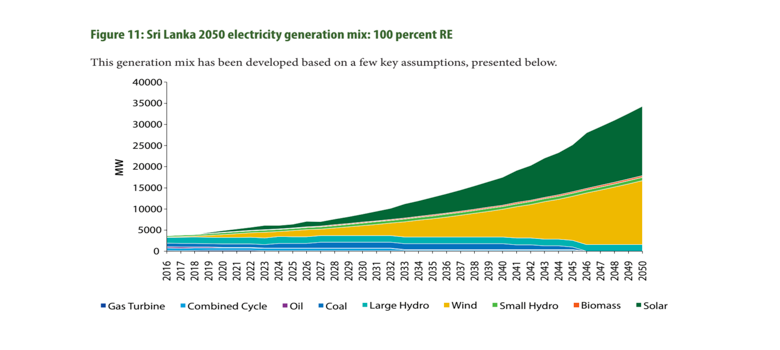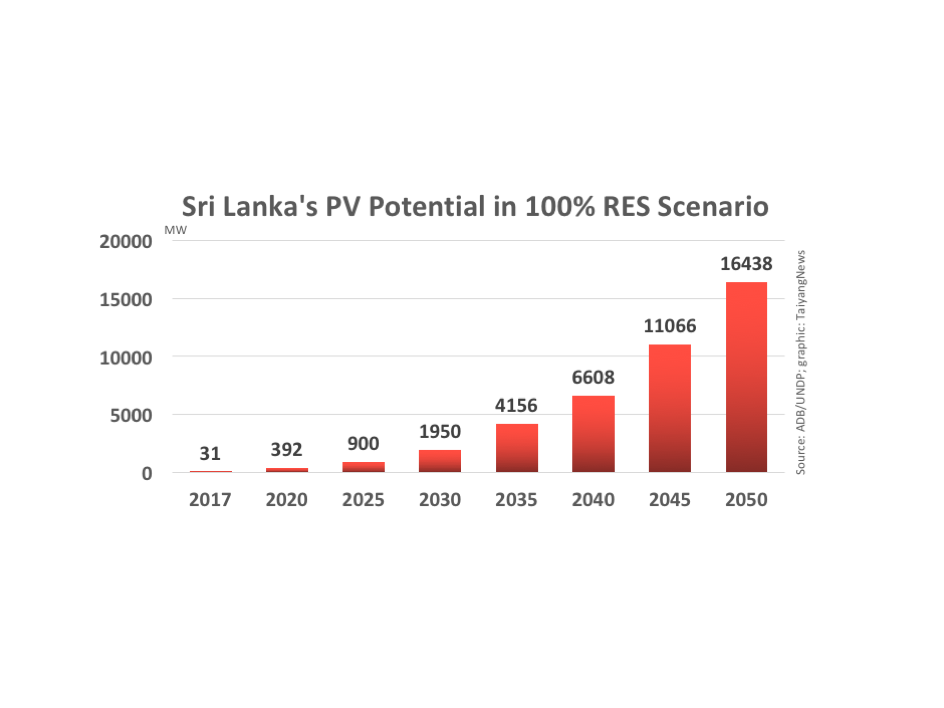- Sri Lanka’s could install 16.4 GW of PV and 15.5 GW of wind power capacity by 2050 to enable a transition towards 100% renewable energy
- Electricity storage solutions can add another 3,600 MW, with 15,000 MWh of energy storage capacity
- Sri Lanka needs $50 billion of total investment by 2050 to be able to afford this transition
- Beyond financial also technological challenges need to be overcome
Sri Lanka has the potential to install solar power generation capacity of 16.4 GW by 2050. This along with another 15.5 GW projected to come from wind energy and balancing coming from hydro and biomass based power plants would help Sri Lanka increase its installed electricity generation capacity to around 34 GW from the current 3.9 GW.

The ‘Assessment of Sri Lanka’s Power Sector – 100% Electricity Generation through Renewable Energy by 2050’ report of UNDP and ADB proposes an energy system mainly based on solar and wind power. (photo credit: UNDP/ADB)
In addition, electricity storage solutions have the potential to add 3.6 GW of instantaneous power and 15,000 MWh of energy storage capacity.
These statistics were published in the report titled ‘Assessment of Sri Lanka’s Power Sector-100 percent Electricity Generation through Renewable Energy by 2050’. The work is a joint study of the UN Development Programme (UNDP) and the Asian Development Bank (ADB).
There would be direct monetary benefits with the substitution of imported fossil fuel with renewable energy until 2050. It would reduce the country’s fuel import bill by about $18 billion. For the 100% transition to renewable energy, Sri Lanka needs investments of $50 billion, estimates the report. It would also require developing the ancillary services market.
However, the country aims to build solar power plants with a capacity of up to 115 MW by 2030 as per its Nationally Determined Contributions (NDC) submitted to the United Nations Framework Convention On Climate Change (UNFCCC).
Even as the report concludes that the time now is ripe for Sri Lanka to pursue the target of 100% renewable energy electricity generation, there are a number of challenges it needs to overcome. A key barrier is not having enough domestic capability to fund ambitious projects from commercial banks. Sri Lanka would need low cost finance support from multilaterals and foreign banks.
A strong ancillary system to be able to absorb the high amounts of variable renewable energy would need to be developed. Pump Storage Power Generation (PSPP) would be very important for the success of such a strategy. The high investment cost for renewable sources, such as rather expensive solar rooftop systems, needs to be looked into to make it a commercially viable option. Better financing models are required to ensure the adoption of rooftop solar among the masses, suggests the report.
The report ‘proposes a gradual phase out of fossil fuels from the country’s electricity mix’ to master the manifold challenges to a 100% renewable power systems.
The report can be downloaded for free from the ADB website.












